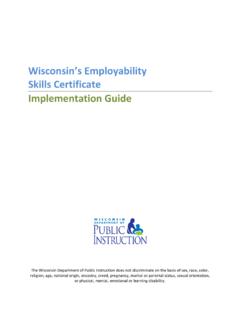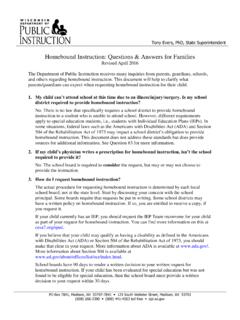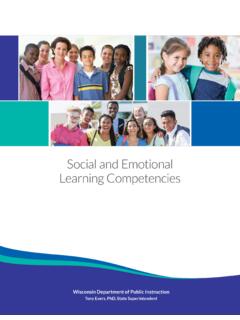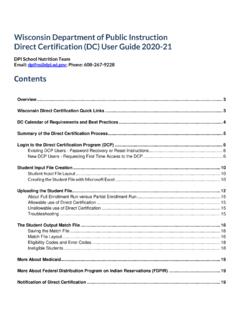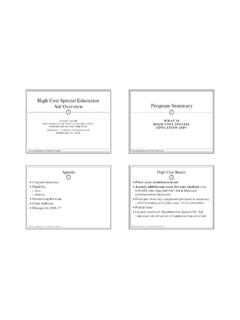Transcription of WISCONSIN STANDARDS FOR Science - dpi.wi.gov
1 WISCONSIN Department of Public InstructionWISCONSIN STANDARDS FOR ScienceWisconsin Department of Public Instruction WISCONSIN STANDARDS FOR Science WISCONSIN Department of Public Instruction Carolyn Stanford Taylor, State Superintendent Madison, WISCONSIN This publication is available from: WISCONSIN Department of Public Instruction 125 South Webster Street Madison, WI 53703 (608) 266-8960 November 2017 WISCONSIN Department of Public Instruction The Department of Public Instruction does not discriminate on the basis of sex, race, color, religion, creed, age, national origin, ancestry, pregnancy, marital status or parental status, sexual orientation or ability. WISCONSIN STANDARDS for Name of Standard iii Table of Contents Foreword .. iv Acknowledgements .. v Section I: WISCONSIN s Approach to Academic STANDARDS .
2 1 Purpose of the Document .. 1 What Are Academic STANDARDS ?.. 2 Relating the Academic STANDARDS to All Students .. 3 Ensuring a Process for Student Success .. 4 Section II: WISCONSIN STANDARDS for Science .. 7 What is Science Education? .. 8 Science Education in WISCONSIN .. 8 STANDARDS Structure .. 10 Section III: STANDARDS .. 19 Crosscutting Concepts .. 20 Science and engineering practices .. 27 Disciplinary Core Idea: Life Science .. 50 Disciplinary Core Idea: Physical Science .. 63 Disciplinary Core Idea: Earth and Space Science .. 77 Disciplinary Core Idea: engineering , Technology, and the Application of Science (ETS) .. 88 Section IV: Disciplinary Literacy: Literacy for Learning in Science .. 104 What is Disciplinary Literacy? .. 105 Why is Disciplinary Literacy Important? .. 105 WISCONSIN Foundations for Disciplinary Literacy.
3 107 What Research and Resources Are Available?.. 108 WISCONSIN STANDARDS for Name of Standard v Foreword On November 13, 2017, I formally adopted the WISCONSIN STANDARDS for Science . This revised set of academic STANDARDS provides a foundational framework that identifies what students should know and be able to do in Science . The adoption of the WISCONSIN STANDARDS for Science was part of a concerted effort led by WISCONSIN educators and stakeholders who shared their expertise in Science and teaching from kindergarten through higher education. The public and legislature provided feedback for the writing committee to consider as part of WISCONSIN s Academic STANDARDS review and revision process. Science is an essential part of a comprehensive PK-12 education for all students. The knowledge, techniques, and citizenry skills gained through Science education in WISCONSIN schools support the overall goal of helping all students become college and career ready.
4 Scientific literacy is a critical elementary of being able to make sense of the world around us, including the abundant information shared in our ever-changing world. The knowledge and skills described provide a framework with actionable indicators for Science classroom experiences. The key goal of the STANDARDS is for students make sense of phenomena and solve problems using scientific content understanding, practices , and ways of thinking. Teaching content for the purpose of covering a set range of topics is not the intent of these STANDARDS ; instead, as research suggests, students should be learning scientific ideas through deeply exploring scientific phenomena and solving culturally relevant, local problems. The WISCONSIN Department of Public Instruction will continue to build on this work to support implementation of the STANDARDS with resources for the field.
5 I am excited to share the WISCONSIN STANDARDS for Science , which aim to build Science skills, knowledge, ways of thinking, and engagement opportunities for all WISCONSIN students. Carolyn Stanford Taylor State Superintendent WISCONSIN STANDARDS for Name of Standard vii Acknowledgements The WISCONSIN Department of Public Instruction (DPI) wishes to acknowledge the ongoing work, commitment, and various contributions of individuals to revise our state s academic STANDARDS for Science . Thank you to the State Superintendent s STANDARDS Review Council for their work and guidance through the STANDARDS process. A special thanks to the Science Writing Committee for taking on this important project that will shape the classrooms of today and tomorrow. Thanks to the many staff members across the division and other teams at DPI who have contributed their time and talent to this project.
6 Finally, a special thanks to WISCONSIN educators, businesspeople, parents, and citizens who provided comment and feedback to drafts of these STANDARDS . WISCONSIN STANDARDS for Science Writing Team Co-Chairs: Eric Brunsell, Associate Professor, UW-Oshkosh; Chief Operations Officer, WI Society of Science Teachers Christine Pratt, Coordinator of Science , Kenosha Unified SD DPI Liaison: Kevin J. B. Anderson, Science Education Consultant, Teaching and LearningSarah Adumat Oshkosh Area SD David Bergerson WI Rapids Public Schools Tony Borden Lakeland Union HS Juan Botella Monona Grove HS Kathy Cady Winneconne HS Faith Fitzpatrick USGS Water sciences Becca Franzen UW-Stevens Point Jay Garvey Shah Sun Prairie SD Adam Keeton Eau Claire Area SD Ryan King Waunakee Area SD Annie Kotenberg Oshkosh Corporation Mike LeDocq Western Technical College Karen Mesmer Independent Consultant Emily Miller UW-Madison Kevin Niemi UW-Madison and WSST Dennis Rohr Seymour SD and WESTA Rochelle Sandrin Milwaukee Public Schools Kaleb Santy Pulaski SD Patti Schaefer Madison Metropolitan SD Hope Schultz Promega Robert Shannon Edgewood HS Jennifer Wilfrid WCER and WIDA WISCONSIN STANDARDS for Name of Standard viii Department of Public Instruction.
7 Academic STANDARDS John W. Johnson, Director, Literacy and Mathematics, and Director for Academic STANDARDS Meri Annin, Lead Visual Communications Designer Marci Glaus, Strategic Communications Consultant David McHugh, Strategic Planning and Professional Learning Consultant Department of Public Instruction Leaders Sheila Briggs, Assistant State Superintendent, Division of Academic Excellence Emilie Amundson, Chief of Staff, Office of the State Superintendent Scott Jones, Special Assistant, Office of the State Superintendent Section I WISCONSIN s Approach to Academic STANDARDS WISCONSIN STANDARDS for Name of Standard 1 Purpose of the Document The purpose of this guide is to improve Science education for students and for communities. The WISCONSIN Department of Public Instruction (DPI) has developed STANDARDS to assist WISCONSIN educators and stakeholders in understanding, developing and implementing Science course offerings and curriculum in school districts across WISCONSIN .
8 This publication provides a vision for student success and follows The Guiding Principles for Teaching and Learning (2011). In brief, the principles are: 1. Every student has the right to learn. 2. Instruction must be rigorous and relevant. 3. Purposeful assessment drives instruction and affects learning. 4. Learning is a collaborative responsibility. 5. Students bring strengths and experiences to learning. 6. Responsive environments engage learners. Program leaders will find the guide valuable for making decisions about: Program structure and integration Curriculum redesign Staffing and staff development Scheduling and student grouping Facility organization Learning spaces and materials development Resource allocation and accountability Collaborative work with other units of the school, district and community WISCONSIN STANDARDS for Name of Standard 2 What Are the Academic STANDARDS ?
9 WISCONSIN Academic STANDARDS specify what students should know and be able to do in the classroom. They serve as goals for teaching and learning. Setting high STANDARDS enables students, parents, educators, and citizens to know what students should have learned at a given point in time. In WISCONSIN , all state STANDARDS serve as a model. Locally elected school boards adopt academic STANDARDS in each subject area to best serve their local communities. We must ensure that all children have equal access to high-quality education programs. Clear statements about what students must know and be able to do are essential in making sure our schools offer opportunities to get the knowledge and skills necessary for success beyond the classroom. Adopting these STANDARDS is voluntary. Districts may use the academic STANDARDS as guides for developing local grade-by-grade level curriculum.
10 Implementing STANDARDS may require some school districts to upgrade school and district curriculums. This may result in changes in instructional methods and materials, local assessments, and professional development opportunities for the teaching and administrative staff. What is the Difference between Academic STANDARDS and Curriculum? STANDARDS are statements about what students should know and be able to do, what they might be asked to do to give evidence of learning, and how well they should be expected to know or do it. Curriculum is the program devised by local school districts used to prepare students to meet STANDARDS . It consists of activities and lessons at each grade level, instructional materials, and various instructional techniques. In short, STANDARDS define what is to be learned at certain points in time, and from a broad perspective, what performances will be accepted as evidence that the learning has occurred.


